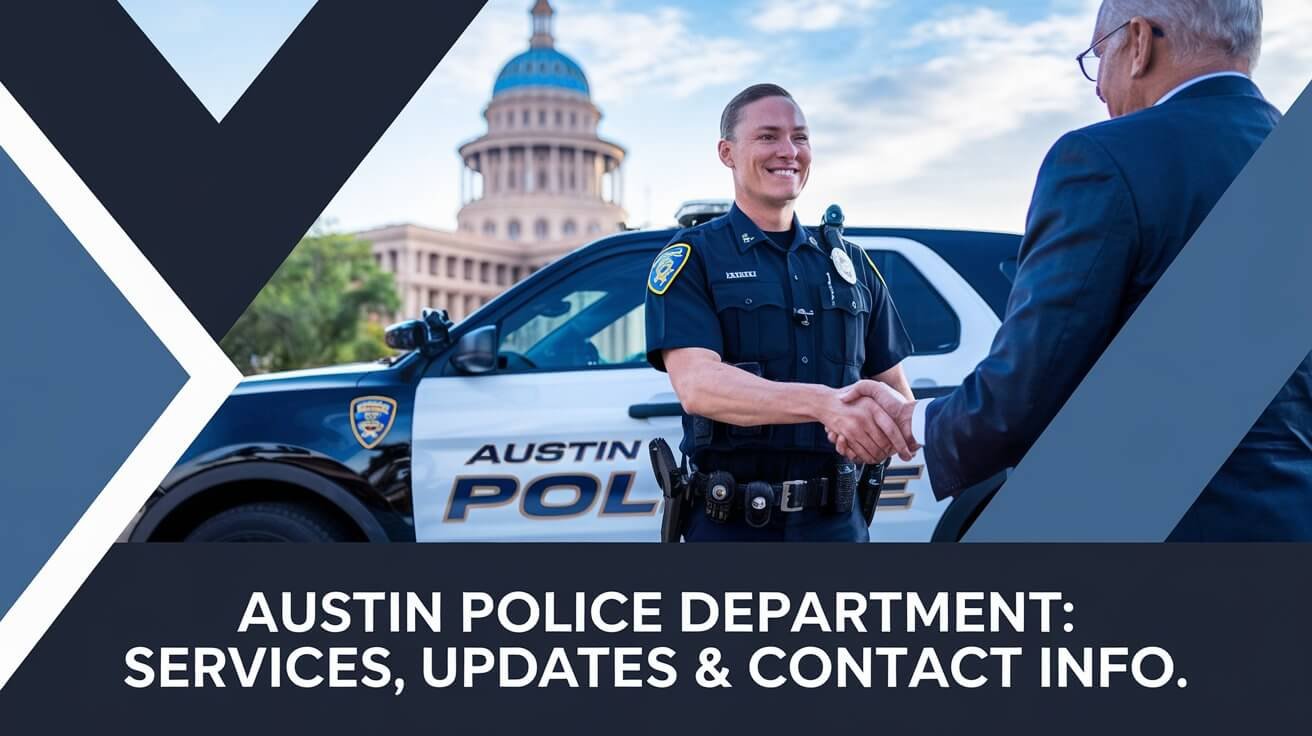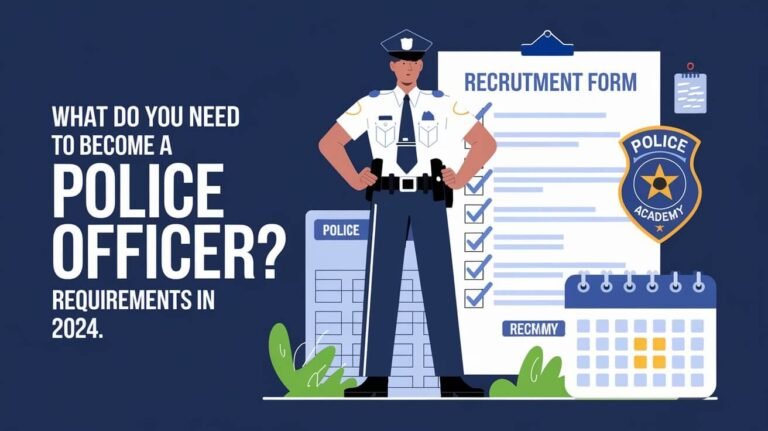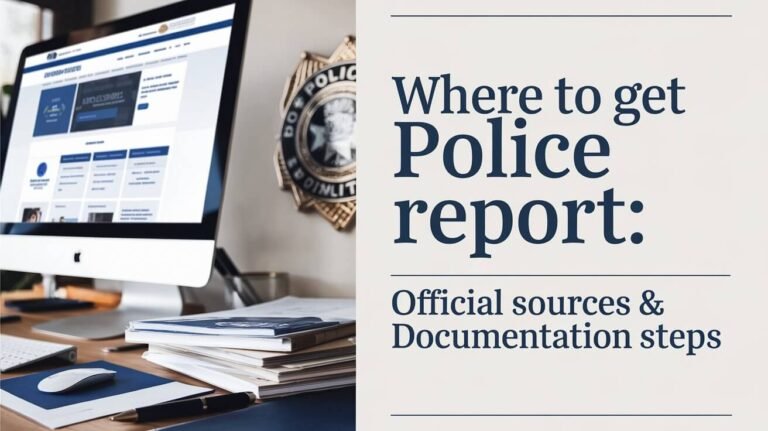Austin Police Department: Services, Updates & Contact Info

The Austin Police Department, or APD, serves the city of Austin, Texas. It focuses on public safety and community policing. The department has about 2,484 people, including 1,809 officers, as of 2022.
APD covers a population of 964,243 people over 296.2 square miles. It has a budget of $443.1 million for 2022. This makes it a trusted and reliable police department in the U.S.
Mission and Core Values of APD
The Austin Police Department aims to serve the community well. It focuses on public safety and community policing. The department’s core values prioritize the community’s safety and well-being.
The APD works hard to build strong partnerships with the community. This ensures everyone feels safe and supported. The department’s commitment to public safety is clear in its efforts to keep the community safe.
The APD’s community policing is all about collaboration and mutual respect. By working with community members, the department can understand their needs better. This helps in reducing crime and improving public safety.
Public Safety Commitment
The APD aims to make the community safe and secure. It does this through community outreach and education programs. The department also focuses on targeted enforcement to tackle specific crime issues.
Community Partnership Philosophy
The APD believes in the power of community partnerships. By working with community members, businesses, and other organizations, the department can tackle complex public safety issues. This approach helps build trust and improves public safety.
Professional Standards
APD is dedicated to upholding high professional standards. It ensures all officers act with integrity and accountability. The department’s training programs focus on ethics, diversity, and community policing.
Maintaining professionalism, the APD can gain the community’s trust. This allows the department to provide effective public safety services.
| APD Initiatives | Goals | Outcomes |
|---|---|---|
| Community Outreach | Build trust and partnerships with the community | Improved public safety, increased community engagement |
| Public Safety Initiatives | Reduce crime and improve public safety | Decreased crime rates, improved quality of life |
| Professional Development | Enhance officer training and accountability | Improved officer performance, increased community trust |
Emergency Response System
The Austin Police Department (APD) has a detailed emergency response system. It’s made to quickly and effectively handle emergencies. The system relies on its dispatch center, where trained dispatchers quickly respond to emergencies.
The APD’s system is part of a bigger network, WarnCentralTexas.org. It covers 10 counties and sends emergency alerts to registered phone numbers. This system gets funding from Homeland Security and local governments.
Some key features of the emergency response system include:
- Emergency notifications based on the 9-1-1 database and a cell phone registry
- Registration for cell phone numbers through a web-based application at WarnCentralTexas.org
- Access to registered phone numbers limited to authorized public safety personnel, ensuring confidentiality
The APD’s emergency response system aims to provide top-notch service. The department works hard to improve its emergency response. With technology and community help, the APD offers excellent emergency service. This makes it a model for effective emergency response.
Community Policing Programs
The Austin Police Department is dedicated to community policing. They have many programs to strengthen ties with the community. These efforts focus on prevention, education, and community involvement. They aim to give residents a chance to help prevent crime and keep their neighborhoods safe.
Some of the community policing programs include:
- Neighborhood watch initiatives, which provide an opportunity for residents to work together to prevent crime and improve community safety.
- Youth outreach activities, which aim to build positive relationships with young people and provide them with opportunities for education and development.
- Business district partnerships, which provide a framework for businesses to work together with the APD to prevent crime and improve community safety.
These programs are key to the APD’s community policing strategy. They show the department’s dedication to making the city safer and more prosperous. By working with the community and providing education and involvement, the APD builds trust and respect.
| Program | Description |
|---|---|
| Community Police Academy | A fourteen-week program that includes a detailed curriculum covering different units within the department each week. |
| Leaders in Knowledge & Support (LinKs) program | A program that targets High School students, fostering understanding of the connection between Law Enforcement and the community. |
| National Night Out | An annual campaign designed to promote positive relationships between community members and police by encouraging community involvement and awareness. |
Public Safety Resources
The Austin Police Department (APD) offers many public safety resources. These include its website and social media channels. They provide lots of info on safety, crime prevention, and community programs.
The APD’s website is a great place for residents to learn about safety. It has tips on preventing crime and info on community programs. These programs show the department’s effort to connect with the community and gain trust.
Some important public safety resources from the APD are:
- Crime prevention tips and advice
- Information on community policing programs
- Updates on the latest news and events
- Resources for victims of crime
APD is dedicated to giving the community top-notch safety resources. Its website and social media are just a few examples. By using these resources, people can stay informed and help keep their community safe.
| Resource | Description |
|---|---|
| APD Website | Provides information on public safety, crime prevention, and community policing programs |
| APD Social Media | Offers updates on the latest news and events, as well as a platform for community engagement |
| Crime Prevention Tips | Provides advice and guidance on how to prevent crime and stay safe |
Austin Police Department Structure
The Austin Police Department has a detailed structure with various units and divisions. It’s designed to offer effective law enforcement to the community. The structure includes specialized units, patrol divisions, and an investigation bureau. This ensures all law enforcement aspects are covered, from emergency response to community policing.
The APD has 24 specialized units, like the SWAT team and K-9 unit. These units handle high-risk situations. The patrol divisions cover the community, divided into sectors. The investigation bureau solves crimes, staffed by detectives who aim to bring justice.
Specialized Units
- SWAT team
- K-9 unit
- Traffic unit
- Auto Theft Unit
- Burglary Unit
Patrol Divisions
The APD has patrol divisions for different city sectors. They work together to provide effective patrol services. These divisions are key to maintaining public safety.
Investigation Bureau
The investigation bureau handles crime investigations. It’s staffed by detectives who solve cases and bring justice. This bureau is vital to the APD structure, ensuring effective law enforcement services.
| Unit | Description |
|---|---|
| SWAT team | Trained to respond to high-risk situations |
| K-9 unit | Trained to assist in searches and apprehensions |
| Traffic unit | Responsible for enforcing traffic laws and investigating accidents |
Crime Prevention Services
The Austin Police Department (APD) has many crime prevention services. These include a crime prevention unit and community policing programs. They aim to strengthen ties with the community and offer chances for residents to help prevent crime.
Some of the APD’s crime prevention services include:
- Crime prevention tips and information on how to prevent crime
- Community policing programs to build relationships with the community
- Partnerships with local organizations to provide resources and support
APD also gets help from groups like the Texas Crime Prevention Association (TCPA). They offer training and resources for those working in crime prevention. Together, the APD and its partners aim to make the community safer. This is important because property crime happens to 1 in 26 people in Austin.
| Organization | Service | Benefit |
|---|---|---|
| Austin Police Department | Crime Prevention Unit | Provides crime prevention tips and information |
| Texas Crime Prevention Association | Training and Resources | Supports crime prevention professionals |
Using these services, residents can help make their community safer. The APD’s crime prevention efforts are key to keeping Austin safe. By working together, we can achieve this goal.
Training and Professional Development
The Austin Police Department (APD) focuses on training and growth to help officers serve the community well. The APD’s training aims to give officers the skills and knowledge needed for their jobs. This ensures they can do their duties safely and effectively.
APD training academy has a detailed curriculum. It includes physical training, academics, and skills training. Cadets go through tough training, like physical fitness tests, academic exams, and skills like firearms handling and defensive tactics. To pass, cadets need to score at least 80% on physical tests and keep an 80% average on all exams.
Cadet Program
The cadet program is a key part of the APD’s training efforts. It gives new recruits the chance to learn the skills and knowledge needed to become police officers. The training is usually Monday through Friday, from 7 a.m. to 4 p.m. Sometimes, nights and weekends are also required.
Continuing Education and Specialized Certifications
The APD also offers ongoing education and specialized certifications for its officers. These programs help officers develop specific skills and keep up with new law enforcement methods and technologies. The APD’s dedication to ongoing training ensures its officers are ready to face the challenges of modern law enforcement.
Some important parts of the APD’s training and professional development include:
- Physical training to ensure officers are physically fit and able to perform their duties safely
- Academics, including instruction on legal topics such as the Code of Criminal Procedure and Texas Penal Code
- Skills training, including firearms handling, driving, and defensive tactics
- Specialized certifications, such as crisis intervention and hostage negotiation
Victim Support Services
The Austin Police Department (APD) is dedicated to helping those hurt by crime. The APD’s victim services unit offers support and advocacy. They work with other groups to help victims heal.
APD’s services include counseling and help finding safe places. They also have a 24-Hour Crisis Hotline at 512-472-HELP (4357). The APD partners with groups like the National Domestic Violence Hotline and the Crime Victim’s Compensation program.
Here are some resources for victims of crime:
- 24-Hour Crisis Hotline: 512-472-HELP (4357)
- SAFE Alliance: 512-267-SAFE (7233)
- National Domestic Violence Hotline: 1-800-799-SAFE (7233)
- Crime Victim’s Compensation: 512-936-1200 or 1-800-983-9933
These resources offer support and help to victims. The APD is committed to working with these groups. They aim to make our community safer and more supportive for everyone.
Technology and Innovation
The Austin Police Department (APD) is all about using new tech to keep everyone safe. They use digital systems and maps to track crimes in real-time. This helps them respond faster and keeps the community informed.
The APD has cool tools like Computer Aided Dispatch Systems (CAD) and Records Management Systems (RMS). These are made by Versaterm, a company that offers cloud-based systems and apps. They also have drones for surveillance and rescue missions.
These technologies bring many benefits, such as:
- Quicker emergency responses
- Real-time crime maps for better awareness
- Efficient reporting and record-keeping
- Improved communication among officers
Thanks to these advancements, the APD is making Austin a safer place. They’re working smarter and building trust with the community.
| Technology | Description |
|---|---|
| Computer Aided Dispatch Systems (CAD) | Enables dispatchers to quickly and accurately assign units to emergencies |
| Records Management Systems (RMS) | Provides a centralized database for storing and managing incident reports and other records |
| Drone Technology | Supports crowd surveillance, SWAT operations, and search and rescue missions |
Community Feedback Channels
The Austin Police Department (APD) values your feedback. It helps build trust and improve services. The APD makes it easy for you to share your thoughts on their programs and services.
Effective feedback channels make a big difference. For example, the Seattle Police Department saw a 60% jump in feedback after making their form easier to use. The Boston Police Department also noticed a 25% drop in minor crimes and a 30% rise in good interactions with the community.
The APD listens through its website and social media. The Office of Police Oversight (OPO) also helps by reviewing feedback. In its first year, the OPO got over 800 messages, including thanks for officers’ good work.
The APD’s feedback channels offer many benefits. They include:
- More transparency and accountability
- Higher community trust and satisfaction
- Better interactions and relationships between the community and police
- Decisions based on data and community needs
Listening to you, the APD can serve the community better. It shows their dedication to making policing more accessible and trustworthy. This helps address community issues and strengthens the bond between the public and the police.
| Department | Feedback Channel | Outcome |
|---|---|---|
| Seattle Police Department | Mobile-responsive, multilingual feedback form | 60% increase in feedback submissions |
| Boston Police Department | User-friendly feedback forms | 25% decrease in minor offenses, 30% increase in positive interactions |
| Austin Police Department | Website and social media channels, OPO | Improved community trust and satisfaction, enhanced community-police interactions |
Special Operations and Events
The Austin Police Department (APD) handles special operations and events with great care. They have teams ready for major events and emergencies. These teams are trained to face high-risk situations.
The APD’s special operations are key to keeping Austin safe. For instance, they secure the South by Southwest (SXSW) festival, which draws hundreds of thousands. They also respond to natural disasters and emergencies.
Some notable events and operations include:
- Major event security: The APD secures big events like SXSW, which had over 300,000 attendees in the music portion.
- Emergency response teams: The APD’s emergency teams are ready for high-risk situations, including natural disasters and emergencies.
- Special operations training: The APD’s special teams get regular training to prepare for various situations.
The APD’s special operations are vital to the department’s mission. They aim to keep the community safe during big events and emergencies. By providing strong security and emergency response, the APD makes sure events are safe and successful for everyone.
| Event | Attendance | APD Response |
|---|---|---|
| SXSW | Over 300,000 | Major event security |
| Texas Military Department’s Open House | Over 5,900 | Special operations support |
Final Verdict
The Austin Police Department (APD) is dedicated to keeping the community safe. They focus on public safety and work closely with the community. This approach helps them stay up-to-date with the city’s needs.
Recently, the city approved a contract worth over $217 million. This shows their commitment to supporting the APD. They want to improve emergency responses, community programs, and help for victims.
The APD’s budget is set to grow to over $600 million by 2030. The city must manage its money well to support all services. The Austin Police Oversight Act shows the community wants more openness and accountability.
The APD is working hard to build trust with the people of Austin. They aim to make the city safer and more vibrant for everyone. Their focus on training and new technologies shows their commitment to excellence.
Always improving and adapting, the APD is a strong protector of public safety. They are dedicated to serving and protecting Austin’s residents.
Popular Post Queries
What is the mission and core values of the Austin Police Department (APD)?
APD focuses on public safety, community partnership, and professional standards. It aims to serve the community well and build strong partnerships.
What is the APD’s emergency response system?
The APD has a fast emergency response system. It includes a dispatch center and units like SWAT and K-9. They quickly respond to emergencies.
What community policing programs does the APD have?
The APD runs many community programs. These include neighborhood watches, youth outreach, and business partnerships. They help prevent crime and build trust.
What public safety resources are available from the APD?
The APD offers many safety resources. You can find them on its website, social media, and through crime prevention services. They help keep the community safe and informed.
How is the APD structured?
The APD is structured with different units and divisions. These work together to serve the community. It’s a complex but effective structure.
What crime prevention services does the APD offer?
The APD’s crime prevention unit and community programs offer many services. They include tips and ways for residents to help prevent crime.
How does the APD train and develop its officers?
APD is dedicated to training its officers. It has programs like the cadet program and continuing education. Officers also get specialized certifications.
What victim support services are available from the APD?
The APD’s victim services unit and counseling help victims of crime. They provide support and advocacy to help victims recover.
How does the APD use technology and innovation?
APD uses digital systems and real-time crime mapping. These tools improve safety and community policing efforts.
How can the community provide feedback to the APD?
The APD welcomes feedback through its website and social media. Residents can share their thoughts and concerns.
What special operations and events does the APD handle?
APD handles major event security and emergency response. They ensure safety and security during special events and emergencies.






